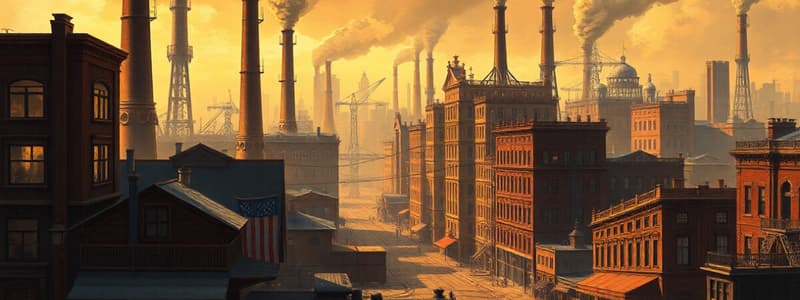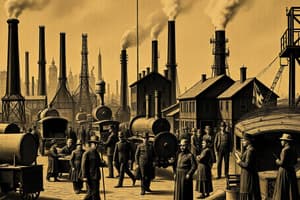Podcast
Questions and Answers
The Gilded Age was marked by significant industrialization and urbanization.
The Gilded Age was marked by significant industrialization and urbanization.
True (A)
During the Gilded Age, the wealth gap between the rich and the poor decreased significantly.
During the Gilded Age, the wealth gap between the rich and the poor decreased significantly.
False (B)
Labor unions emerged as a response to the harsh working conditions during the Gilded Age.
Labor unions emerged as a response to the harsh working conditions during the Gilded Age.
True (A)
The term 'Gilded Age' suggests a time of superficial prosperity hiding serious issues.
The term 'Gilded Age' suggests a time of superficial prosperity hiding serious issues.
Powerful industrialists during the Gilded Age were often referred to as 'breadbaskets.'
Powerful industrialists during the Gilded Age were often referred to as 'breadbaskets.'
Flashcards
Rapid Industrialization in the Gilded Age
Rapid Industrialization in the Gilded Age
This era (late 1800s) saw a boom in US industries like factories and railroads, leading to job growth and increased production. New technologies like the Bessemer process, which made steel production more efficient, contributed to this rapid growth.
Urbanization in the Gilded Age
Urbanization in the Gilded Age
The population moved from rural areas to rapidly growing cities, seeking jobs in factories and businesses. This influx created opportunities for economic advancement but also challenges like overcrowding and poverty.
Rise of Big Business in the Gilded Age
Rise of Big Business in the Gilded Age
Powerful industrialists like Andrew Carnegie and John D. Rockefeller controlled large industries, building monopolies and trusts. This led to concerns about unfair business practices as corporations sought to dominate markets.
Labor Movements in the Gilded Age
Labor Movements in the Gilded Age
Signup and view all the flashcards
Social Inequality in the Gilded Age
Social Inequality in the Gilded Age
Signup and view all the flashcards
Study Notes
Overview of the Gilded Age
- The Gilded Age, spanning the last quarter of the 19th century in the US, was a period of significant industrialization, urbanization, and economic growth.
- It featured rapid technological advancements, corporate expansion, and immense wealth concentration among a small elite.
- Despite a prosperous facade, significant social and economic inequalities existed.
- The term "Gilded Age" symbolizes this duality; a glittering surface masking underlying issues.
Key Characteristics of the Gilded Age
-
Rapid Industrialization: The expansion of factories, railroads, and other industries fueled economic growth, creating job opportunities and increasing production.
- New technologies like the Bessemer process for steel production drove industrialization.
- Advanced transportation networks facilitated trade and communication.
-
Urbanization: Population shifted from rural areas to burgeoning cities seeking factory and business jobs.
- Rapid city growth brought economic opportunities but also overcrowding and poverty.
- Urban centers faced infrastructure, sanitation, and public health challenges.
-
Rise of Big Business: Powerful industrialists ("robber barons") consolidated industries under their control.
- Figures like Andrew Carnegie and John D. Rockefeller amassed enormous wealth.
- Monopolies and trusts raised concerns about economic power and unfair business practices.
- Corporations employed legal strategies and governmental regulations to manipulate markets and gain advantages, sparking public debate.
-
Labor Movements: Workers faced harsh conditions in factories and mines.
- Labor unions emerged advocating for better wages, hours, and safety regulations.
- Strikes like the Great Railroad Strike of 1877 and the Homestead Strike highlighted labor-management conflicts.
- Labor movements championed worker rights and improved conditions, driving social and political change.
-
Social Inequality: The wealth gap widened substantially.
- A small elite accumulated immense wealth while many struggled with poverty and inequality.
- This disparity exacerbated sanitation, safety, and public health issues, creating a substantial social divide.
Political Landscape of the Gilded Age
-
Patronage and Political Machines: Political machines, controlling local politics, often relied on patronage and corruption to stay in power.
- The spoils system and corruption eroded public trust and fueled social unrest.
- Political corruption hindered progress and prevented needed reforms.
-
Rise of Populism: Farmers and laborers organized to oppose economic inequality.
- Populist movements gained traction, advocating for government regulations to protect worker and farmer interests and promote economic growth.
-
Reform Movements: Social reformers and activists addressed poverty, inequality, and corruption.
Key Figures of the Gilded Age
- Industrialists: Andrew Carnegie, John D. Rockefeller, Cornelius Vanderbilt
- Political Figures: Grover Cleveland, Rutherford B. Hayes
- Reformers and Activists: Jane Addams
Cultural Trends of the Gilded Age
- Growth of Cities: Urban culture thrived with entertainment like theaters and museums.
- Literature and Art: Literature and art reflected social changes and tensions, highlighting societal issues.
Lasting Impacts of the Gilded Age
- Progressive Era: Gilded Age issues spurred Progressive Era reforms.
- Modern Economic Systems: The Gilded Age established the framework for modern American capitalism and industrial society.
- Social and Political Reforms: Tensions from the Gilded Age led to policy shifts and growing social awareness.
Studying That Suits You
Use AI to generate personalized quizzes and flashcards to suit your learning preferences.




